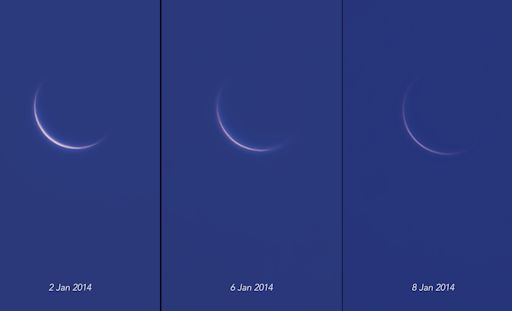 01-9-2014, 06:16 AM
01-9-2014, 06:16 AM
|
#802
|
|
⊙▃⊙
  
Join Date: Nov 2007
Location: I live in the last place where you Look.
Age: 31
Posts: 7,376
|
 Re: Terry's Astronomy Thread.
Re: Terry's Astronomy Thread.
Daily Suspicious0bserver's Weather Post:
January 9, 2014
What's in the sky tonight?
January 9, 2014
-A large coronal mass ejection (CME) from the Sun should start hitting Earth's magnetosphere around 8:00 UT January 9th (3 a.m. EST, midnight PST).
-The CME comes from a big sunspot region that's currently visible to the unaided eye through a safe solar filter or a #14 rectangular arc-welder's filter.
-NOAA forecasters estimate a 90% chance of geomagnetic storms on Jan. 9th when a CME is expected to hit Earth's magnetic field. The speed of the solar wind around Earth could spike to 700 km/s (1.6 million mph) shortly after the impact, sharply compressing Earth's magnetosphere. High-latitude sky watchers should be alert for auroras.
-Venus is turning its night side toward Earth as it approaches inferior solar conjunction on Jan. 11th. Less than 1% of Venus's sunlit hemisphere is now facing us, which means the planet looks like a razor-thin crescent. If you have a GOTO telescope, command it to slew to Venus. It's visible even in broad daylight.
-Shahrin Ahmad of Sri Damansara, Malaysia, took these pictures on Jan. 2nd, 6th and 8th using a 4.5 inch telescope. "It us very interesting to see how fast Venus changes in only 6 days! Today the thinning crescent is only 0.7% illuminated at a distance of 7o from the sun."
 Astro Picture of the Day:
January 9, 2014
Source:
Astro Picture of the Day:
January 9, 2014
Source:
This telescopic close-up shows off the otherwise faint emission nebula IC 410 in striking false-colors. It also features two remarkable inhabitants of the cosmic pond of gas and dust below and right of center, the tadpoles of IC 410. The picture is a composite of images taken through narrow band filters. The narrow band image data traces atoms in the nebula, with emission from sulfur atoms in red, hydrogen atoms in green, and oxygen in blue. Partly obscured by foreground dust, the nebula itself surrounds NGC 1893, a young galactic cluster of stars that energizes the glowing gas. Composed of denser cooler gas and dust the tadpoles are around 10 light-years long, potentially sites of ongoing star formation. Sculpted by wind and radiation from the cluster stars, their tails trail away from the cluster's central region. IC 410 lies some 12,000 light-years away, toward the constellation Auriga.
|

|

|